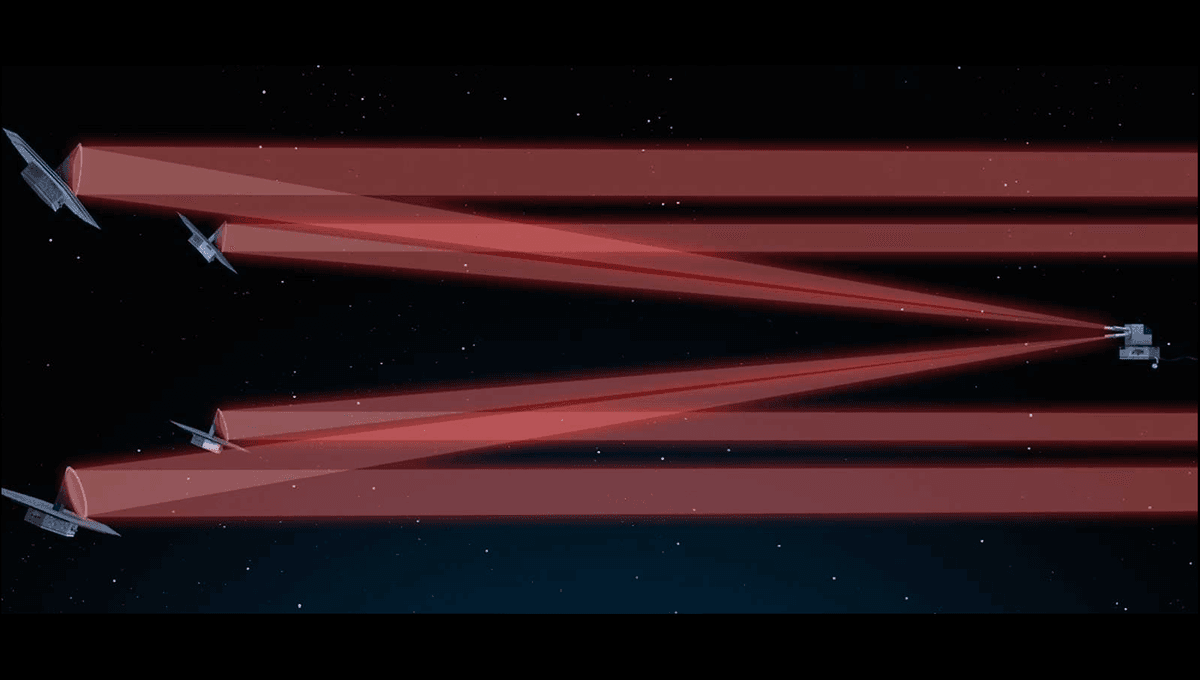The techniques a network of satellites may one day use to find life beyond the solar system have been verified by applying them to the one place we know life exists: Earth. Of course, there is a rather spectacular difference in the distance over which the observations needed to be made versus those planned for the future, but it’s still a bar that needed to be cleared.
The astronomers behind the Large Interferometer for Exoplanets mission signaled the scale of their ambition when they chose the acronym LIFE. By combining the powers of five satellites the hope is that LIFE will do what even the JWST can’t, find evidence of biology occurring on rocky exoplanets (planets orbiting nearby stars).
Like the JWST, the proposed satellites will be positioned at Lagrange Point 2. Using interferometry to combine the light collected by each, they will act for some purposes like a single telescope more powerful than anything we know how to launch.
This combination will not be able to do all the things a larger single telescope can – but that doesn’t matter if you only have one job. “Our goal is to detect chemical compounds in the light spectrum that hint at life on the exoplanets,” said the leader of the initiative Professor Sascha Quanz of ETH Zurich in a statement.
To test the viability of the idea before spending billions, Quanz and three other researchers took observations of Earth made by the Atmospheric Infrared Sounder aboard NASA’s existing Aqua satellite. The team explored Earth’s spectrum in the mid-infrared range, where LIFE will operate.
If aliens in another star system were looking at Earth with a LIFE-like instrument, they would truly see a pale blue dot with nowhere near the resolution to distinguish oceans from continents, let alone anything smaller. Instead, they would see a spectrum that would be the average for the Earth as a whole. Moreover, they’d need to spend a long time looking to get enough photons for anything useful, so the spectrum would also be averaged over time, potentially smearing out seasonal changes.
We don’t get to pick the angles from which we see rocky planets either, so the team considered how Earth would look from a system located over the North Pole (orbiting Polaris perhaps). Then they added one over Antarctica and two equatorial views.
By taking a subsample of Aqua Earth’s data equivalent in size to the amount of radiation a telescope would collect at great distances, the team validated LIFE’s approach. Specifically, they concluded LIFE would be able to detect carbon dioxide, ozone, and methane in Earth’s atmosphere to distances of at least 33 light years in all three orientations.
We know that lifeless planets can have carbon dioxide in their atmospheres, or we would know something big about Mars and Venus. Water is a requirement for life, but no guarantee of it. Methane can have sources other than biological ones, but nevertheless, its presence on Earth is greatly promoted by living organisms, and there’d be no ozone here either if plants or algae weren’t constantly replenishing atmospheric oxygen. In combination, the four gasses are a powerful indication Earth is inhabited by something, even if you couldn’t tell it had developed beyond a single cell.

The spectrum of the gas giant WASP-96 b has peaks at the places expected for water, but finding something similar for a smaller rocky planet will take something still more powerful
Image Credit: NASA, ESA, CSA, and STScI
“Even if atmospheric seasonality is not easily observed, our study demonstrates that next generation space missions can assess whether nearby temperate terrestrial exoplanets are habitable or even inhabited,” Quanz said.
LIFE, as they say, has found a way.
One fly in the ointment is that LIFE might need to spend up to 100 days staring at the same point to collect usable data for these gases. That might be viable if we already had a very big hint about a specific planet, but if it was just one among many to look at it would be hard to justify. Fortunately, however, for many priority targets, the time required would be much smaller.
The team is also seeking even bigger giveaways, such as nitrous oxide or methylbromide, but an accompanying paper suggests the range at which these could be found may be limited to just 16 light years.
The study is published open access in The Astronomical Journal.


